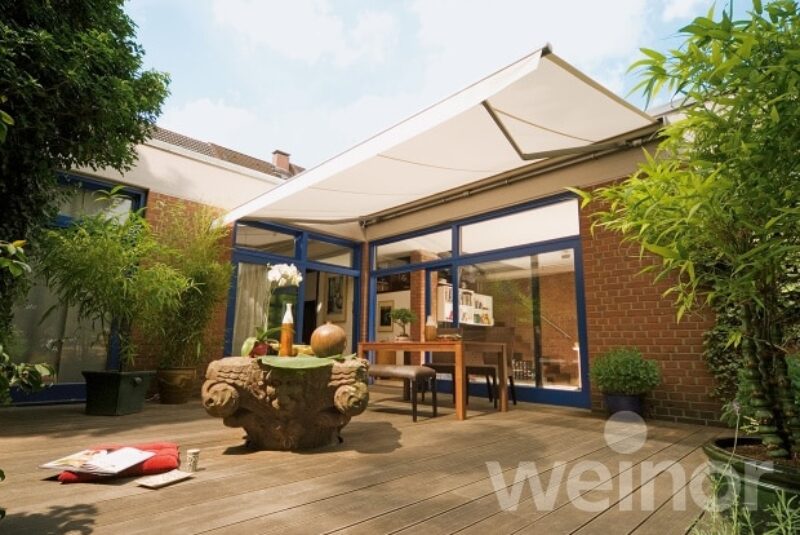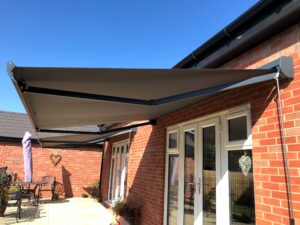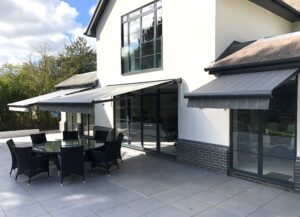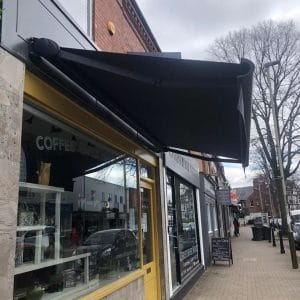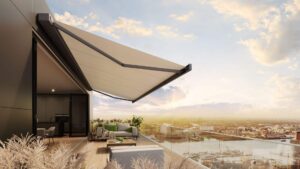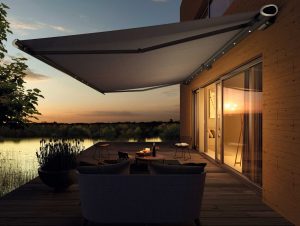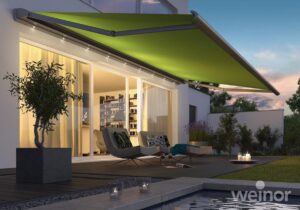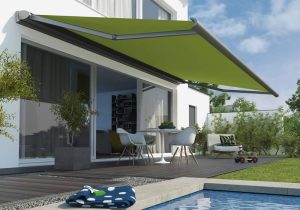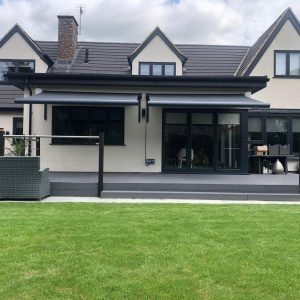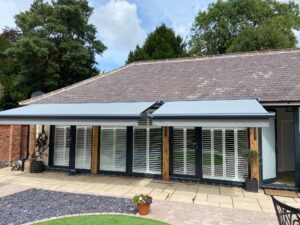Everything You Need to Know About Awnings
Awnings are a wonderful addition to any property, combining style and functionality in one practical solution.
Whether you’re looking to enhance your outdoor living area, protect your home from the elements, or add a touch of sophistication to your business, awnings can deliver.
In this guide, we’ll walk you through everything you need to know about awnings, including the various styles available, how they’re made, what they’re used for, how they’re fitted, and tips for cleaning and maintenance.
Understanding Awnings
Awnings are coverings attached to the exterior of a building, often extending over doors, windows, or outdoor spaces.
Their primary function is to provide shade and protection from the elements, such as sunlight, rain, and even snow. Modern awnings, however, do more than just shield; they enhance the aesthetics of your property and increase the usability of outdoor areas.
Traditionally, awnings were made of basic canvas stretched over a simple frame. Today, technological advancements have led to a wide range of materials, styles, and features, making awnings versatile and adaptable to various needs and tastes.
Styles of Awnings
Awnings come in several styles, each designed for specific purposes and aesthetics. Retractable awnings, for instance, are among the most popular choices. These allow you to extend or retract the awning as needed, providing the flexibility to enjoy the sun or retreat into the shade.
They are particularly suited for patios, decks, and balconies. Many modern retractable awnings feature motorised systems for ease of use, and some even include sensors that adjust automatically based on weather conditions.
Fixed awnings, on the other hand, offer a permanent solution. These are great for creating consistent shade and are commonly used over windows or doors. They are highly durable and often used in commercial spaces to offer both functionality and a professional appearance.
Freestanding awnings are another option, perfect for creating independent shaded areas in gardens or poolside spaces. These structures are not attached to buildings, giving you more flexibility in their placement.
Drop-arm awnings are particularly useful for windows, offering excellent sunlight control while maintaining privacy. They provide a classic look that works well with both modern and traditional architecture.
Finally, vertical awnings function similarly to blinds, providing vertical shade and acting as a barrier against wind or low sunlight. They are especially useful in outdoor dining areas or patios.
How Awnings Are Made
Modern awnings are made with a combination of durable materials to ensure they stand up to various weather conditions. The fabric used in awnings is a key component.
Acrylic fabrics are a popular choice for their durability and resistance to fading, while polyester fabrics are lightweight and cost-effective. Vinyl-coated fabrics offer exceptional protection against UV rays and mildew, making them a good option for long-term use.
The frame of an awning is just as important as the fabric. Most frames are constructed from aluminium, which is lightweight, rust-resistant, and low-maintenance. Steel is another option, offering sturdiness and durability, although it requires rust protection.
For those seeking a rustic or traditional aesthetic, wooden frames are sometimes used, but these require more upkeep.
Mechanisms for retractable awnings can be either manual or motorised. Motorised systems are increasingly common and often come with advanced features like weather sensors, remote controls, and app integration, making them highly convenient.
Uses of Awnings
Awnings are incredibly versatile and serve a variety of purposes. One of their primary functions is to provide shade and sun protection.
By reducing direct sunlight, they make outdoor spaces more comfortable and help maintain cooler indoor temperatures, potentially lowering energy bills. Awnings also protect furniture, flooring, and other interior elements from fading due to sun exposure.
In addition to sun protection, awnings offer shelter from very light rain, enabling you to enjoy your outdoor space regardless of the weather. High-quality awnings with robust fabrics can even handle slightly heavier rain or snow, depending on the design.
Beyond their practical benefits, awnings add a touch of style to any property. They enhance architectural features and are available in a wide array of colours, patterns, and designs, making it easy to find one that complements your home or business.
Awnings are also excellent for expanding usable space. They create shaded outdoor areas that are perfect for entertaining guests, dining al fresco, or simply relaxing. For businesses, awnings can provide a welcoming entrance or extend seating areas, especially in cafés and restaurants.
Fitting an Awning
Installing an awning requires careful planning to ensure it is safe, durable, and functional.
The first step is to decide on the location and measure the area accurately. Consider the height, width, and projection of the awning to ensure it fits the space and provides adequate coverage.
The type of surface where the awning will be mounted is also an important factor. Awnings can be attached to brick, wood, or concrete walls, but the mounting hardware must be chosen carefully to support the weight of the structure.
For retractable awnings, the mounting process is more complex, as they require additional support for the mechanism.
While some smaller awnings come with DIY installation kits, professional installation is often recommended, especially for motorised or large-scale awnings. A professional ensures the awning is securely fixed and operates smoothly, giving you peace of mind.
Cleaning and Maintenance Tips
Regular cleaning and maintenance can significantly extend the life of your awning and keep it looking its best. Start by cleaning the fabric periodically to remove dirt, debris, and stains.
Use a soft brush or vacuum to dust off loose particles, and clean stains with a mild soap solution and a sponge. Always rinse thoroughly and allow the fabric to air dry. Avoid using harsh chemicals, as these can damage the protective coating of the fabric.
The frame of the awning also requires attention. Inspect metal frames for rust or corrosion and apply a rust-resistant paint or treatment as needed. For retractable awnings, keep the moving parts well-lubricated with a silicone-based lubricant to ensure smooth operation.
Seasonal maintenance is particularly important. Before winter, retract the awning and cover it with a protective layer to shield it from snow and ice. After heavy rain, ensure the fabric is completely dry before retracting it to prevent mould or mildew growth.
Why Invest in an Awning?
Investing in an awning is a smart way to enhance your property’s functionality and aesthetic appeal.
Awnings provide practical benefits such as shade, weather protection, and increased energy efficiency, while also adding a touch of style. With so many designs, materials, and features to choose from, there’s an awning to suit every need and budget.
Whether you’re a homeowner looking to create a cosy outdoor retreat or a business owner seeking to improve customer experience, awnings offer a solution that combines practicality with elegance.
With proper care and maintenance, a high-quality awning can last for years, providing long-term value and comfort.
Conclusion
Awnings are a versatile and stylish solution for improving outdoor spaces and protecting your property from the elements.
By understanding the different styles, materials, and uses, you can make an informed decision about the best awning for your needs. With the right care and maintenance, your awning will continue to provide shade, comfort, and beauty for years to come.
Whether you’re looking to upgrade your home or business, an awning is an investment that delivers both practicality and visual appeal.
Should you have any more questions, please feel free to contact the Fraser James Blinds team. We are friendly, professional and always more than happy to help. Alternatively, should you wish to arrange a home visit, you can easily do so within the vast amount of areas we cover.

